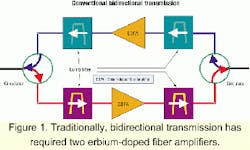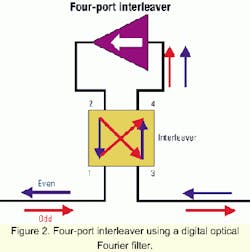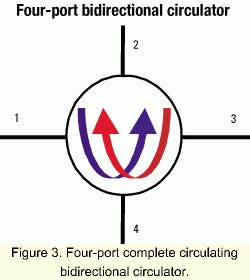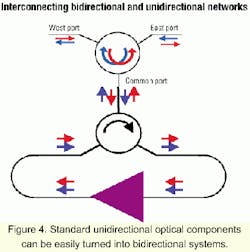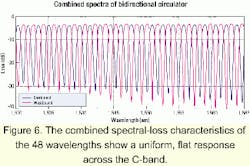Metro traffic both ways
Recent component developments enable low-cost bidirectional transmission.
KUOCHOU TAI, BILL CHANG, JYEHONG CHEN, THOMAS DUCELLIER, and YIHONG CHEN, JDS Uniphase
New fiber components will enable the implementation of bidirectional transmission methods that can substantially increase the capacity of metropolitan networks without a significant cost premium. Past approaches to bidirectional transmission did not receive widespread implementation because of crosstalk between opposing submitted channels. This limitation is almost entirely removed with the development of a birefringent interleaver filter, which can be combined with a non-reciprocal birefringent filter to deliver near-complete blockage of backreflected channels. The resulting components (i.e., bidirectional isolator, bidirectional circulator, four-port interleaver) enable the use of standard unidirectional optical components to create bidirectional networks that deliver twice the spectral efficiency of unidirectional networks. While other approaches to higher spectral efficiency, such as 40-Gbit/sec transmission, may be more appropriate for the long-haul core arena, bidirectional transmission offers the ideal solution for metro networks, because it delivers unprecedented levels of network capacity utilizing relatively inexpensive components.
Rapidly increasing demand for high-bandwidth services has created the need for more efficient methods to provision, manage, store and transport the ever-increasing data flow at the local level. Local carriers are beginning to deploy fiber on the ground, and DWDM is emerging as the technology of choice for handling metro capacity requirements as well as providing bandwidth to users. This technology uses prisms to separate colors into different wavelengths of light that each carry separate channels of information on a single fiber strand. It dominates the optical core of the network, where the current state of the art provides 80 channels at 10 Gbits/sec. Meanwhile, the market is moving toward a new generation of core systems capable of delivering 160 channels at 40 Gbits/sec each.While such fiber-optic equipment is still quite expensive, it is more cost-effective than competing technologies for carrying the huge long-haul traffic load of today's public networks. For example, increasing transmission speed to 40 Gbits/sec requires the use of undeveloped indium phosphide (InP) integrated-circuit technologies and emerging adaptive polarization-mode dispersion (PMD) technology that currently remains too expensive for many long-haul applications. Similarly, the use of narrow-spacing filters and polarization multiplexers to increase the channel count in long-haul applications is effectively ruled out for the foreseeable future by considerations of cost.
The case is different for metro markets, since both the amounts of information transmitted and the distances involved are orders of magnitude smaller. These conditions make it harder to justify the use of the highly specialized and often costly long-haul technologies. Nevertheless, engineers developing metro-network equipment still face the same two basic options in improving spectral efficiency or the number of bits that can be transmitted per gigahertz of spectrum: increasing the transmission speed or reducing the occupied bandwidth per channel.
Whichever one of these alternatives or combination thereof is chosen, engineers must also develop the resulting products at a much lower cost to ensure their commercial viability for the metro market. Metro-network engineers face a further challenge, the limit to which a fiber network can be scaled down to help address cost concerns. Currently, four strands of fiber are regarded as the minimum that can be laid for a metro network-one strand each for west and east transmission and the other two serving as a backup.Bidirectional transmission offers the potential to overcome these problems because of its inherent ability to increase the amount of information that can be delivered without the need to install additional fiber lines. It doubles spectral efficiency by sending opposing signals over the same channel in different optical phases. While this ability would benefit any part of the network, bidirectional transmission has a special and particular appeal in metro applications since it provides the lowest-cost alternative for increasing network capacity. In addition to avoiding the expense of the technologies usually deployed to achieve substantial increases in transmission speed or reductions in channel bandwidth, bidirectional transmission offers the practical convenience of using a single fiber for both east- and west-bound transmissions, reducing by half the number of fibers needed to complete a typical metro link.
Backreflection problems have complicated bidirectional transmission since the technology was first proposed in the 1970s. Some of these problems are localized and may be caused by defective components or splices. Other backreflections are distributions, particularly the phenomenon known as Rayleigh back scattering, which can lead to crosstalk between opposing transmitted channels and produce oscillation in bidirectional amplifiers-at least those that have been available up to now. Of course, localized backscattering can easily be resolved by using different wavelength allocations for the eastbound and westbound transmissions. But doing so reduces spectral efficiency and thus negates one of the principle advantages of bidirectional transmission.Another long-standing problem with bidirectional transmission involves optical signaling. The conventional practice has been to build a ring using two circulators and two erbium-doped fiber amplifiers (EDFAs). Because EDFAs amplify an optical signal directly, without complicated and expensive electronic circuitry, these devices have largely replaced earlier generations of amplifiers that required an optical-electrical-optical conversion at each stage of amplification.
The main problem in introducing bidirectional transmission into this design has been the need for additional components to process the second opposite-traveling signal-two EDFAs, two circulators, and four comb filters at each stage of amplification-which necessarily increases costs (see Figure 1). Second, each of the additional components through which the optical signal passes adds either noise, in the case of active components, or loss, in the case of passives. The typical noise figure introduced by an EDFA is 5.5 dB, while the insertion loss caused by the filters and circulators can be estimated at 1 dB each. Further, the gain provided by the EDFAs is limited due to self-oscillation caused by Rayleigh backscattering.
An isolator that simultaneously blocks backreflected eastbound channels traveling west and backreflected westbound channels traveling east is key to overcoming these limitations. Such an isolator has recently been developed and consists of a non-reciprocal birefringent filter, which separates a randomly polarized light beam into two plane-polarized components (see Figure 2). The crystal presents a different index of refraction to each polarized component, causing the components to be refracted at different angles and exit the crystal in separate directions. One of these two polarized components is called the "extraordinary ray" (E-ray) and is plane-polarized perpendicularly to the other ray, called the "ordinary ray" (O-ray).The filter is made of (2n+1) crystals, n>1, of length equal to c/(ΔnFSR), where c is the speed of light, Δn is the birefringence, and FSR is the free spectral range. A particular design has been realized to perform 200-GHz non-reciprocal interleaver filtering, in which eastbound and westbound transmissions are offset by 100 GHz.
The specific device has a maximum, worst-case insertion loss of 0.8 dB, less than 0.1 dB polarization-dependent loss and isolation in excess of 30 dB over 37 GHz, with insertion-loss ripple less than 0.25 dB over the isolation band. PMD and chromatic dispersion are negligible by design (below 0.1 psec and 10 psec/nm, respectively) but have not been tested.
This directional isolator makes it possible to duplicate the functionality of the components while only requiring one EDFA (instead of two) and one filter (instead of four). The result is longer transmission distances because of reduced noise and loss, simplified design, and substantial reduction in costs.
The device is well suited for use with a three-port or four-port bidirectional circulator (see Figure 3). In a three-port bidirectional circulator, the westbound propagating channels circulate from port 3 to port 2 to port 1 and the wavelength-interleaved eastbound channels circulate from port 1 to port 2 to port 3. This device realizes an insertion loss of only 1.6 dB per port connection and has a peak isolation in excess of 45 dB. These figures are, of course, far superior to those that can be realized with conventional bidirectional technology; in the case of isolation, the figures obtained were limited by the capabilities of the measurement device. The 30-dB isolation band spans over 36 GHz, with low insertion-loss ripple observed across the band. Frequency centering is better than 3 GHz across the entire C-band (191.7 to 196.4 THz) with very uniform performance. Again, PMD and chromatic dispersion are negligible by design. Further, the design of this component is based on an athermal structure, with typical temperature stability in the 3-GHz range from 0 to 70°C.The equivalent of a dual-pass bidirectional isolator is created by connecting a broadband mirror to the common port of the same circulator device. With peak-to-valley isolation in excess of 90 dB over the entire C-band, the potential is clearly outstanding. The insertion loss would be 3.1 dB, worst case, and the 60-dB isolation bandwidth would be in excess of 43 GHz, with the insertion-loss ripple over this bandwidth lower than 0.5 dB. It is interesting to note that this new bidirectional isolation technology provides a significantly larger usable bandwidth (at least more than the entire C-band) than conventional unidirectional isolation technology.
A major obstacle to the wide deployment of bidirectional networks is the need to avoid backreflections throughout the network. Any splice defect, backreflection from an optical device, or simply backscattering in the optical fiber itself has a dramatic impact on overall system performance. With the proposed technology, this problem is completely alleviated: A component with significant back reflection can now be isolated from the optical amplifiers by sandwiching it between two bi-isolators. The flexibility in isolation level (single or dual pass) and location will greatly facilitate network design and reduce overall cost since components with relaxed backreflection specifications can now be used.
The bicirculator can also be used in a wide range of new applications. Basically, a standard reflective device designed for unidirectional networks can be connected to the common port of a bidirectional circulator to become a bidirectional component. This adaptability will greatly reduce the overall cost of bidirectional networks since the same optical devices can be used both for unidirectional and bidirectional DWDM systems. Typical examples of such applications would be the use of fiber Bragg gratings or thin-film filters to enable the realization of bidirectional add/drop nodes where any wavelength can be added or dropped at a node, regardless of its propagation direction. Other applications of the bicirculator could be found for network monitoring, dynamic gain equalization, and dispersion compensation.
Another important application of the bicirculator is to provide a transparent all-optical interface to interconnect bidirectional and unidirectional optical networks. This interface has four ports and uses a bicirculator together with an ordinary circulator. The operation of the device is as follows: For westbound propagating channels, the light travels from port 1 to port 3 and port 4 to port 2, while for the wavelength-interleaved eastbound propagating channels, the light travels from port 2 to port 3 and port 4 to port 1. Ports 1 and 2 are connected to bidirectional traffic, while ports 3 and 4 are unidirectional (see Figure 4). This four-port device transforms any unidirectional transmission device into a bidirectional one by feeding the light from port 3 through the optical device, then connecting it to port 4. For example, bidirectional amplification can be achieved using standard (single-directional) EDFAs. This capability would certainly provide large savings for the implementation of bidirectional networks, since current commercially available DWDM components could be utilized for bidirectional networks. In addition, the four-port device realizes a network interface between wavelength-interleaved bidirectional networks and standard DWDM networks. This transparent all-optical interface would allow a bidirectional backbone to be connected to local DWDM unidirectional networks.A new inline optical amplifier configuration using the bidirectional circulator and a single unidirectional gain medium has recently been tested in a transmission experiment of 48x10-Gbit/sec, 100-GHz, WDM channels, interleaved, over 2x100-km spans of conventional singlemode fiber (see Figure 5). The performance of the 48 channels, equally split between eastbound and westbound directions, was tested and measured with a variation in electrical signal-to-noise ratio (SNR) of less than 0.87 dB. No indication of adjacent channel impairments was observed. The experiment demonstrates the feasibility of this approach for bidirectional transmission involving multiple spans of interleaved channels.
The bidirectional transmission test setup comprises a symmetric structure with two sets of transmitters, each carrying 24 channels. Each set of transmitters is individually modulated with a 2 3 1 -1 non-return-to-zero 10-Gbit/sec pseudo-random binary-sequence pattern by a Mach-Zehnder external modulator. The two sets of wavelengths, westbound and eastbound, range from 1,530 to 1,560 nm. Each set is on a 200-GHz grid and is offset by 100 GHz from each other. The wavelength sets are amplified using a wideband, gain-flattened optical amplifier, with an average power level of 6 dBm per channel. Dispersion pre-compensation of 1,700 psec/nm is implemented using bulk, broadband, conventional dispersion-compensation modules mid-stage in the optical amplifiers. The signals are transmitted through 100-km standard singlemode fiber before being amplified by the inline bidirectional optical amplifier. The links have two 100-km spans with a loss of 20 dB for each span. Two circulators were used to tap the signal out for testing.
The inline bidirectional optical amplifier consists of a bidirectional circulator, a circulator, and a gain-flattened EDFA. The spectral-loss characteristics of the combined circulators show a uniform flat response across the entire C-band with a measured isolation of better than 30 dB. The combination has a low input and output loss of between 3.5 and 4 dB. With the addition of the EDFA, the inline bidirectional optical amplifier has excellent wideband performance. The gain spectra of the eastbound and westbound channels both have a flatness of better than 1.5 dB (see Figure 6).
After each set of wavelengths passes through 200 km of fiber, individual channels are selected using a 1-nm tunable filter. This bandpass filter provides more than 20 dB of suppression of neighboring channels. A low-noise, single-channel optical preamplifier is then used to boost the signal; a final post filter then removes the amplified spontaneous emission.
For the 10-Gbit/sec signal detection, a commercial photodetector with external clock recovery circuitry was used. During the measurements, the eastbound and westbound wavelength sets were adjusted separately to equalize levels before they enter the inline bidirectional optical amplifier.
The performance was characterized by measuring the bit-error rate (BER) as a function of the incident power at the receiver with bidirectional transmission of all 48 channels. From the eye-diagram, the electrical SNR was calculated at a given BER (better than 1x10). A typical eye-diagram detected at 1,543.73 nm for an optical power of -9 dBm showed a BER of better than 10 with a measured electrical SNR of 7.2 dB (compared to 13.5 dB for the back-to-back single-channel received signal). The channels from both wavelength sets were selected and characterized. All channels operated at better than 1x10 with a maximum variation in electrical SNR of 0.87 dB. This small difference in performance showed no wavelength-dependent trends.
Bidirectional transmission offers an exciting new option for the high-growth metropolitan-network space by offering dramatic improvements in spectral efficiency at a much lower cost than the alternatives used in the long-haul market.
The newest development utilizes a birefringent optical filter combined with non-reciprocal optical elements to deliver bidirectional isolation that ranges from 45 dB peak-to-valley for single pass to a potential of 90 dB peak-to-valley for dual pass over the entire C-band, with low loss, large flat-top bandwidth, low polarization-dependent loss, low PMD, near-zero chromatic dispersion, near-zero chromatic dispersion, and good temperature stability. Standard unidirectional optical components can be easily used to create bidirectional networks with the new bicirculators. Products based on this technology will soon be reaching the market and can be expected to lead to dramatic improvements in metro-networking performance.
Kuochou Tai and Bill Chang are principal engineers and Jyehong Chen is a field applications engineer at JDS Uniphase (San Jose, CA); Thomas Ducellier is manager, micro-optics component research at JDS Uniphase (Ottawa, Canada); and Yihong Chen is a senior scientist at JDS Uniphase (Freehold, NJ).
